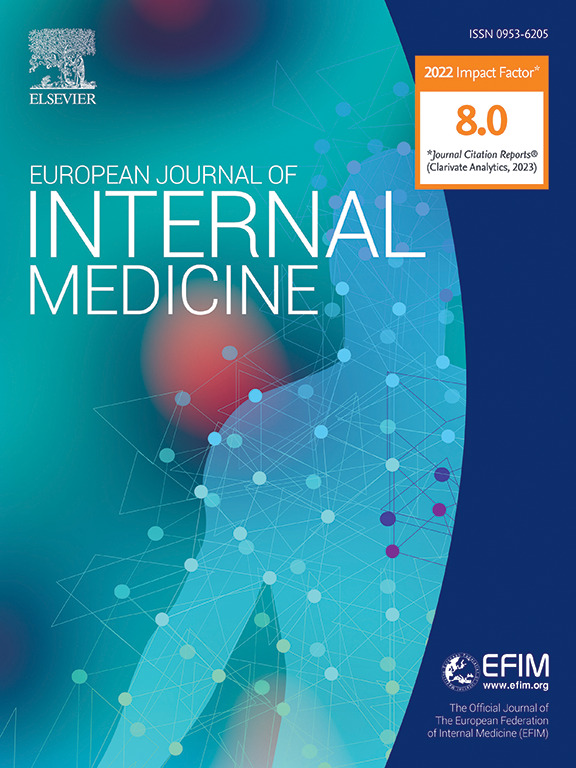冠心病患者甘油三酯水平的研究
IF 6.1
2区 医学
Q1 MEDICINE, GENERAL & INTERNAL
引用次数: 0
摘要
背景:临床试验表明,尽管积极降低LDL-C,但仍存在残留风险,部分与高TG水平有关。以色列的冠心病患者即使在住院后也没有达到推荐的LDL-C目标水平。我们的印象是TG水平也是一样的。目的:探讨冠心病患者的甘油三酯水平及治疗方案。设计和方法:对2020-2022年因心绞痛综合征入住内科病房的冠心病患者进行回顾性队列研究的亚分析。对入院时、出院前6个月、出院后3个月和6-9个月的人口统计学和临床特征、TG水平和降脂治疗进行评估。还评估了影响TG水平的因素,并对非常高的TG水平给予了关注。结果:该队列包括10540例患者。三分之二的患者TG水平< 150 mg/dL。在水平≥150mg /dL的受试者中,4- 6%患有严重的高甘油三酯血症(≥500mg /dL)。在三分之二TG水平≥150 mg/dL的患者中,HbA1c水平为bb0 6.4%。严重的高甘油三酯血症患者有较高的不受控制的糖尿病发生率。大多数受试者接受了他汀类药物治疗,无论他们的TG水平如何。贝特类药物的使用非常低,但严重高甘油三酯血症患者的使用明显较高。住院治疗对短期治疗和TG水平没有显著的临床影响。结论:大多数冠心病患者TG水平得到控制。然而,应该对糖尿病患者给予额外的关注。进一步的教育和严格的政策是必要的。本文章由计算机程序翻译,如有差异,请以英文原文为准。
The approach to triglyceride levels in patients with coronary heart disease
Background
Clinical trials demonstrate residual risk despite aggressive LDL-C lowering, partialy realated to high TG levels. CHD patients in Israel do not reach the recommended LDL-C target levels, even after hospitalization. Our impression is that it is the same regarding TG levels.
Objectives
Exploring the TG levels among CHD patients and adressing specific therapeutic regimens needed.
Design and methods
A sub-analysis of a retrospective cohort study of CHD patients who were admitted to internal medicine wards because of anginal syndrome during 2020–2022. The data was evaluated for demographic and clinical characteristics, TG levels and lipid lowering treatment at admission, 6 months previously, 3 months and 6–9 months after discharge. The factors that affect TG levels, with attention given to very high levels, were also evaluated.
Results
The cohort included 10,540 patients. Two-thirds had TG levels < 150 mg/dL. Among the subjects with levels ≥ 150 mg/dL, 4–6 % had severe hypertriglyceridemia (≥ 500 mg/dl). In two-thirds of the patients with TG levels ≥ 150 mg/dL, the HbA1c levels were > 6.4 %. Patient with severe hypertriglyceridemia had higher rates of uncontrolled diabetes mellitus. The majority of subjects received statin treatment, regardless of their TG levels. The use of fibrates was very low, but was significantly higher among patients with severe hypertriglyceridemia. Hospitalization did not have a clinically-significant effect on short-term treatment nor on TG levels.
Conclusions
Most CHD patients have controlled TG levels. However, additional attention should be given to the diabetic ones. Further education and strict policy are needed.
求助全文
通过发布文献求助,成功后即可免费获取论文全文。
去求助
来源期刊
CiteScore
9.60
自引率
6.20%
发文量
364
审稿时长
20 days
期刊介绍:
The European Journal of Internal Medicine serves as the official journal of the European Federation of Internal Medicine and is the primary scientific reference for European academic and non-academic internists. It is dedicated to advancing science and practice in internal medicine across Europe. The journal publishes original articles, editorials, reviews, internal medicine flashcards, and other relevant information in the field. Both translational medicine and clinical studies are emphasized. EJIM aspires to be a leading platform for excellent clinical studies, with a focus on enhancing the quality of healthcare in European hospitals.

 求助内容:
求助内容: 应助结果提醒方式:
应助结果提醒方式:


